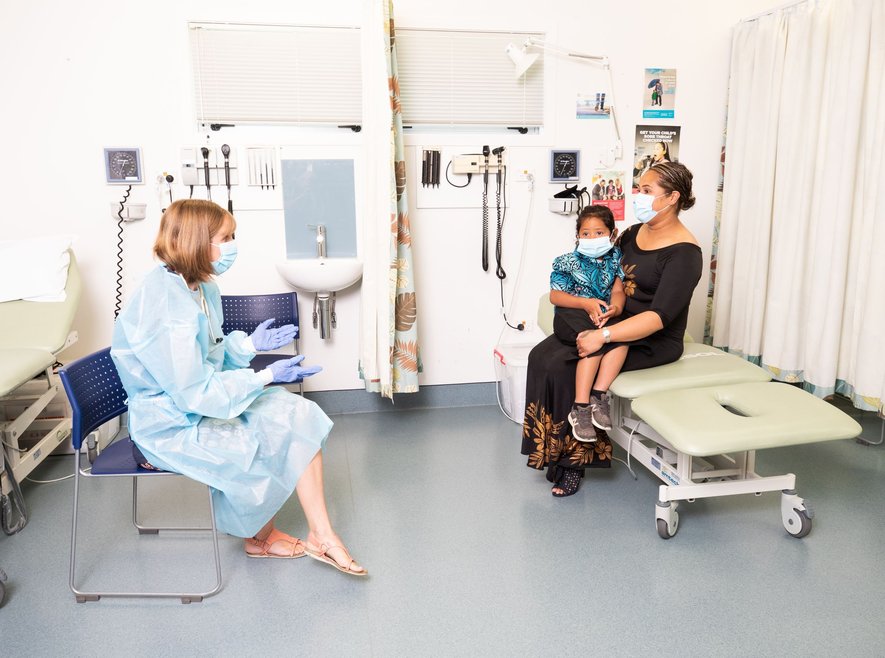12.1 Infection control
Infection control is an important aspect of quality health care. General practices have a high volume of patients coming through, of whom many are unwell and therefore may spread disease. Standard infection control precautions are universal and the best line of defence and can prevent the spread of infections among patients and team member
| Standard - what we'll be assessing | Evidence to provide for assessment |
|---|---|
|
The practice ensures the practice has and follows active infection control procedures aligned to NZS 8134:2021 and AS/NZS 4815:2006 (if reprocessing reusable medical devices) |
|
Standard precautions
Standard precautions include:
- hand hygiene
- use of personal protective equipment (e.g., gloves, masks, eyewear)
- respiratory hygiene/cough etiquette/ventilation measures
- sharps safety
- safe injection practices
- sterile instruments and devices.
General practices differ greatly in their day-to-day function and it is not possible to have a ‘one size fits all’ approach for infection prevention and control.
It's recommended practices determine risk in their own context and then decide on the appropriate course of action. Practices need to regularly conduct infection prevention and control risk assessments within their facilities and ensure all team members understand their responsibilities in managing these risks.
Ventilation
Good ventilation is not the only measure to reduce the risk of airborne particles being transmitted through ventilation systems, but is part of a comprehensive package of protective measures, such as physical distancing, mask wearing, frequent hand washing, etc.
The College recommends these simple steps to help to increase ventilation in the practice and mitigate the risk of disease transmission and contamination.

Health and disability services standards
NZS 8134:2021 Ngā paerewa, the Health and Disability Services Standard, section 5; Infection prevention and antimicrobial stewardship, replaces the previous standard (NZS:8134.3:2008).
It fosters continuous quality improvement (CQI) and is considered best practice for primary care. In order for the practice to document how team members are going to manage infection prevention and antimicrobial stewardship, the College recommends all practices comply with NZS/8134:2021.
If a practice is using reusable medical devices (RMD’s) then 4815:2006 also applies (as set out in the indicator).
Antimicrobial stewardship is about avoiding the unnecessary use of antimicrobials, for example, antibiotics, and making sure that whenever they are used, they are used with care to minimise the risk of antimicrobial resistance. Patients, doctors, nurses and pharmacists all play an important part in antimicrobial stewardship.
In the absence of a national antimicrobial stewardship programme, primary care is excluded adhering to 5.3, 5.4 and 5.5.4 and 5.5.5.
Key features of section 5 of the standard
- 5.1: Governance is accountable for setting up IP and AMS programmes and:
- plan is included in the strategic /other plans
- there is a pathway for reporting IP and APC to the clinical governance group
- significant IP events are managed using the practices significant events and /or incidents reporting system
- 5.2: The IPC programme includes:
- a designated person with oversight and coordination of the IP programme
- having a documented IP programme
- having a suite of IP policies
- a Pandemic plan
- education/training/ induction, relevant to role
- IP personnel involvement in: precuring RMDs, clinical policies, new building design.
- 5.5: Deliver services in a clean environment free of antimicrobial resistant organisms (NB: NZS43.4:2002 still applies)
- safe and effective cleaning processes
- safe and effective laundry processes
- waste management handling

Infection control policies and procedures
NZS 8134:2021, section 5, provides a list of policies which must be included in the practice’s suite of infection prevention policies. However, there may be additional policies required depending on the services a practice provides.
Pandemic planning
General practice will play a key role in both prevention and management of a pandemic. The outcome will revolve around preparation in these three key areas:
- preparation facilitated by using pandemic preparedness checklists
- communication strategies to disseminate information and resource provision including vaccines
- PPE and HR.
Please note the requirement for an outbreak management plan i.e., an epidemic/pandemic response plan in NZS 8134:2021, section 5.
Your pandemic/epidemic response plan will need to be reviewed and updated regularly and have plans for managing each pandemic/epidemic.
The pandemic plan may include:
- workforce management
- environment management
- Ministry of Health guidelines /other identified reputable and agreed sites
- stress management and wellbeing of team members
- triage and assessment processes for suspected Covid19 cases and other acute presentations
- case classification and reporting
- contact identification, investigation and follow up
- patient Information sheets
- referrals and requests to outside providers
- prescribing – alternate practices, for example, e-prescribing
- repeat prescribing policy – specific to current pandemic/epidemic
- supplier details for pandemic/epidemic medical supplies
- situational PPE requirements for team members
- stocktake process for PPE and pandemic specific medical supplies
- communication plan: for team members, patients, PHO
- process for continuous update of risk register
- applicable resources to current pandemic .
The pandemic plan should link in with documented Business Continuity and Emergency Plans.
Sterilising reusable medical devices (RMDs)
AS/NZS4815:2006 has been superseded by AS 5369:2023.
The guidance will be shortly updated to reflect this new standard. In the interim, please continue to adhere to the guidance information below.
If a practice is reprocessing reusable medical and surgical instruments and equipment, RMDs, AS/NZS4815:2006 sets the standard for cleaning, disinfecting and sterilizing reusable medical and surgical instruments and equipment, and the maintenance of associated environments
This criterion captures the main requirements of AS/NZS 4815:2006 in both the evidence requirements and guidance information.
If practices require more in depth information on reprocessing reusable medical and surgical instruments and equipment, AS/NZS 4815:2006 can be purchased.
The standard for reprocessing RMDs requires: Using the correct soaking solution/medium for instruments:
- validation of the sterilization process using ‘indicators’
- cleaning and disinfecting protocols
- planning the work area layout and flow to prevent contamination.
Team members responsible for cleaning, disinfecting, sterilising, storing, and distributing items, need to be trained to ensure they can correctly perform these tasks.
Validation of the steriliser is important. The practice will need to demonstrate how the effectiveness of each sterilisation cycle is monitored, for example, printouts of every cycle, chemical indicator for every load or data logged directly to the computer.
Calibration on site must be done (and documented):
- when steriliser is first installed
- annually
- when serviced or repaired.
For the steriliser, the practice needs a record of annual and current (within the last 12 months):
- servicing
- calibration
- validation.
The practice will also need to provide records if the practice uses an off-site service.
AS/NZS 4815:2006 requires that sterilisation records must be kept for 12 months showing the time and date when each article was sterilised; and the length of time that the article was sterilised and the temperature and pressure levels of the autoclave.
Training and induction
The College has not specified training or frequency of training in favour of practices identifying which training best fits the scope of their individual practices and aligns with the NZ Standards applied to the indicators.
For training recommendations, practices can consult the Ministry of Health, their PHO and/or the manufacturer/retailer of the equipment. The College will also accept correctly documented in-house training.
Training options:
- Instrument reprocessing : An onsite practical workshop on reprocessing instruments /RMDs to the AS 5369:2023 Standard. Email: brent@curis .co.nz
- Training on how to safely operate, monitor and calibrate sterilizers/autoclaves provided through a PHO or from the retailer or manufacturer of the steriliser/autoclave.
- LearnOnline Infection prevention and control 2021.
- ACEhub infection prevention and control courses and sterilisation courses
- An orientation - induction programme which is role specific and includes infection prevention and control, sterilisation, antimicrobial stewardship and waste management, as applicable.
- MoH Part 5: Infection prevention and antimicrobial stewardship.
Links to resources
-
MoH Part 5: Infection prevention and antimicrobial stewardship
-
NZMA journal article on antimicrobial stewardship
-
ADHB Antimicrobial stewardship programme and resources
-
New Zealand Antimicrobial Resistance Action Plan
-
BPAC antimicrobial stewardship guidelines
-
MoH Part 5: Infection prevention and antimicrobial stewardship
-
MOH: Infection prevention and control
-
MOH: Infection prevention and control recommendations
-
RACGP: Infection prevention and control standard
-
bpacnz: Exposure to body fluids: keeping the primary healthcare team safe
-
HQSC: hand hygiene
-
bpacnz: Antimicrobial resistance in New Zealand: What is my role in primary care?
-
Example of a practice pandemic plan
-
RNZCGP: COVID 19 and changes to general practice (Feb 2023)